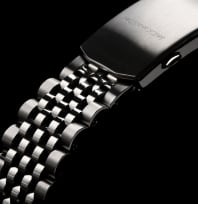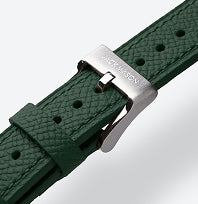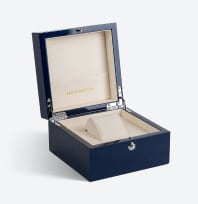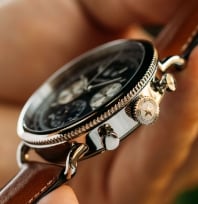As long as watches have existed, so have watch calibers. The caliber, also known as the movement, is a key component of any timepiece. Whereas the case protects the components of the watch, and the dial displays the time, the movement is the mechanism that causes all the movable elements of the watch to function. In this article, we at Jack Mason will endeavor to explain the subtle differences between two types of watch movements: Mechanical and Automatic.
Mechanical Movement: The First of Many
The earliest mechanical watches appeared in the late 15th century and were so large they had to be worn on a belt. Worse, these clocks were only able to measure time by the hour. Subsequent centuries would improve the accuracy and efficiency of these materials, but the basic premise of the mechanical watch movement would remain the same.
A mechanical watch movement starts with a tightly coiled flat spring. Without anything to control its movement, the spring would unspool immediately. However, the spring feeds into a series of slowly turning gears, which themselves are controlled by a secondary spring, called the hairspring. Jeweled bearings within the watch protect it from vibration and other motions which would otherwise damage or morph the internal components.
The late 19th and early 20th centuries would see the mass production of mechanical wristwatches, and WWI would solidify the significance of contemporary mechanical watches forever. Before the 20th century, mechanical wristwatches were predominantly used by women exclusively. By the end of the First World War, it became commonplace for soldiers to wear wristwatches and thus be able to read the time while keeping both hands free to fight. Nearly six years after Armistice Day, however, a rival to the old mechanical watch emerged.
The Entrance of the Automatic Watch
In 1924, John Harwood filed a patent for the world’s first automatic wristwatch. In truth, the history of the automatic watch is disputed, having started sometime in the late 18th century, but it is undisputed that Harwood brought automatic watches to the forefront as a convenient alternative to mechanical watches.
The patent showed many improvements over older mechanical watches. Much of the interior remained similar, with one crucial difference: The automatic watch, true to its name, was self-winding. Whereas a mechanical watch needed to be hand-wound and would stop functioning after a few days without this maintenance, Harwood’s automatic watch held an oscillating weight that would wind the spring in response to the wearer’s kinetic energy.
In layman’s terms, the simple act of moving while wearing the watch winds the spring, which then unspools in a manner similar to that in ordinary mechanical watches. Otherwise, automatic watches are still operated by similar machinery to that in mechanical watches.
Here, we reveal to you the secret of these two watch varieties: All automatic watches are also mechanical watches. Both these watch movements use mechanical components to keep time, as opposed to quartz watches, which use electricity to power their movement. For the sake of clarity, we will still be using “mechanical” to refer to non-self winding watches, specifying all mechanical watches where relevant.
Winding Your Watch
All mechanical watches still need to be wound, though automatic watches rarely need to be manually wound. A mechanical watch should, ideally, be wound every day, as its movement becomes less accurate the less taut the mainspring becomes. To wind any kind of mechanical watch, simply wind the crown clockwise. Once it has been properly wound, the watch should produce a bit of friction, essentially telling you it has been wound enough. Overwinding can damage the delicate machinery, but only if you force it well beyond the resistance point.
Automatic watches, on the other hand, cannot be overwound. They are created with specific mechanisms designed to prevent this from happening. If the natural movement of your wrist is not enough to power the movement on a sedentary day, or if you have not worn it and thus not powered it in a long time, gently shaking, winding, or rotating the watch should be enough to restart its movement. If you have an extensive collection of automatic watches, it is even possible to purchase a watch winder to wind your automatic watches while they are not being worn.
Durability and Accuracy of Different Watch Movements
We will briefly discuss quartz movement again to offer a comparison between quartz watches and all mechanical watches. Quartz watches attained popularity in the 1970s and offered a sometimes sleeker, battery-powered alternative to mechanical and automatic watches. It is no secret that quartz watches, with their electrical components, have mechanical and automatic watches beat when it comes to accuracy. Mechanical and automatic watches both begin to lose accuracy as they come unwound, though not so severely as to render them definitively inferior. However, quartz watches do have some significant aesthetic differences from mechanical and automatic watches that merit discussion. In quartz watches, the movement of the second hand has a staccato, “tick tick” appearance, owing to the movement. In mechanical and automatic watches, the movement of the second hand is consistent and sweeping, owing to the constant spring or rotor movement occurring inside the watch.
How Do Mechanic Watches Differ in Feel From Automatic Watches?
The internal differences in mechanical and automatic movements force some exterior differences as well. Mechanical watches are filled with delicate, precise machinery and dozens of moving parts that are sometimes so small that they require special tools made for watch repair. Many mechanical watches will have partially clear cases to expose the intricacy of the machine, turning the machine on your wrist into a work of art, in addition to a fashion piece and practical part of your attire.
Automatic watches, however, tend to be larger and weightier than their mechanical counterparts. The machinery inside, the weight, in particular, is larger and heavier than the internal components of mechanical watches. In some watches, it is possible to physically hear and feel the rotor moving as you rotate the watch, which to some may be a deterrent and to others may be a euphoric reminder of the craftsmanship they wear.
Practical Considerations for the Watch Wearer
Mechanical and automatic watches do share some similar weaknesses, and we would be remiss not to mention them here. Being mechanical, both are susceptible to the magnetism found in television, speakers, and other technology, as well as electric shocks. The negative impact these may have is easily fixed by merely adjusting the time when you have a nearby clock to use for reference.
A more practical issue, depending on your activity level, is the mechanical watch’s durability in regard to water. All watches are water-resistant to a degree while not being water-proof, but regular mechanical watches, in particular, are sensitive to moisture due to the complex array of precise machinery operating the movement. While a drop of water here and there would not cause the destruction of a watch, we recommend leaving your mechanical watch off for swimming unless the piece in question is a diver’s watch or otherwise has a high water resistance.
Mechanical vs. Automatic: Pro and Con
After this, you should feel a little more comfortable around the different types of watch movements, even if the debate over which one is best is not going away any time soon. Below, we are going to summarize some of the strengths and weaknesses of mechanical and automatic watches.
Mechanical
Pro:
- Elegant machinery and movement.
- Many vintage watches will be mechanical.
- Longevity, if properly cared for.
Con:
- Needs daily winding.
- Will lose accuracy as it comes unwound.
- Generally more sensitive than quartz counterparts.
Automatic
Pro:
- Self-winding
- Smooth, sleek second-hand movement.
- Cheaper and easier maintenance than regular mechanical watches.
Con:
- Will need to be rewound if you are inactive or not a daily wearer.
- Noise and feel of weight moving may be a pro or con, depending on preferences.
Many of the strengths and weaknesses of automatic and mechanical watches are similar. This is because they both have a closely related heritage, the former belonging to the larger, latter group. Mechanical watches may not be for everyone. Certainly, automatic watches are significantly simpler in regard to upkeep for those of you who find yourself on the go more often than not. Whichever route you take, the level of detail bestowed upon these watches is something not to be missed.
Mechanical Vs. Automatic: The Final Analysis
By now, you have learned about the storied history of mechanical timepieces and had a chance to view some of the complications they have and continue to overcome. In our opinion, it is not up to a single authority to declare automatic or mechanical watches to be superior.
We believe that they are both of equal value, whether you choose to wind by hand or by the strides you take in your life every day. What we can say in confidence, however, is that by wearing any kind of watch, you are dedicating yourself to interacting with a degree of craftsmanship and innovation whose history is as elegant as its execution.
Sources:
History of Watchmaking I Haute Horlogerie
How World War I Changed Watches Forever I Bloomberg
Over-Winding A Watch: Automatic vs Mechanical vs Hand-Wound I The Slender Wrist












